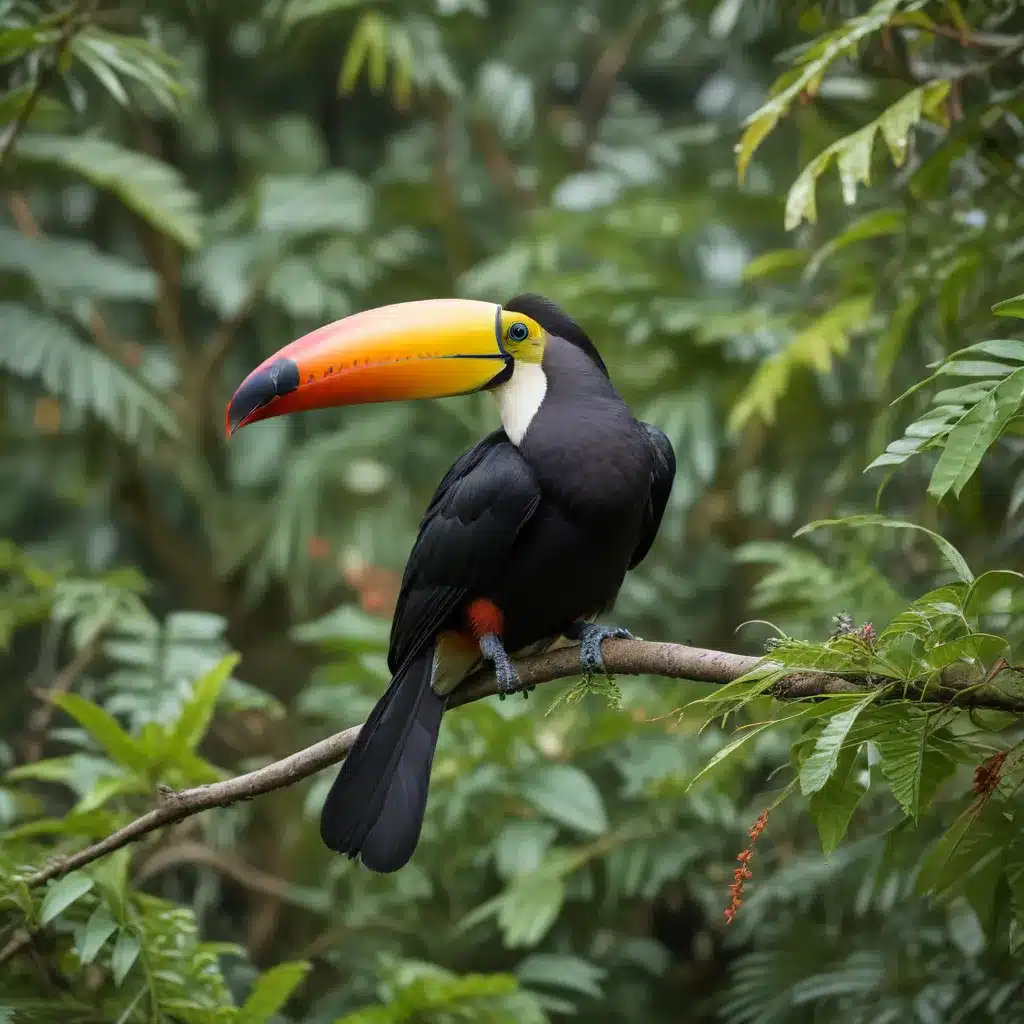
Avian Habitat Design
As an experienced avian caretaker, I’ve had the pleasure of working with countless species over the years. But one group that holds a special place in my heart is the toucans – those vibrant, charismatic birds with their oversized, colorful beaks. Toucans are truly a marvel of nature, and crafting the perfect habitat for these fascinating creatures is a delicate art form.
Avian Species Considerations
Toucan Characteristics
Toucans are members of the Ramphastidae family, a diverse group of tropical birds found across Central and South America. These medium-sized birds are instantly recognizable by their massive, vividly-colored bills that can measure up to one-third the length of their entire body. But toucans’ striking appearance is more than just a visual treat – their unique beaks are actually a highly specialized adaptation.
Habitat Requirements
In the wild, toucans inhabit the lush, humid rainforests of their native range. They prefer the upper canopy levels, where they can forage on a variety of fruits, flowers, insects, and even small vertebrates. Toucans also require spacious, densely-vegetated areas to nest, with natural cavities or abandoned holes serving as prime nesting sites.
Behavioral Adaptations
Beyond their distinctive beaks, toucans have other fascinating adaptations that shape their behavior and habitat needs. For instance, their zygodactyl feet – with two toes facing forward and two backward – allow them to grip and perch on branches with ease. Toucans are also renowned for their loud, raucous calls, which they use to communicate and establish territories within the dense forest.
Habitat Design Principles
When it comes to creating the ideal toucan habitat, whether in a zoo, sanctuary, or private collection, there are several key principles to keep in mind. Replicating the birds’ natural environment as closely as possible is crucial for their physical and mental well-being.
Structural Elements
The foundation of any successful toucan habitat is the enclosure itself. These birds require spacious, multi-tiered enclosures that allow them to freely move, climb, and fly. Vertical space is particularly important, with a minimum height of 10-15 feet recommended. Incorporate a variety of perches at different levels, including natural branches, ropes, and platforms, to encourage natural roosting and perching behaviors.
Vegetation Selection
Toucans are intimately connected to the lush, verdant forests of their native range, so replicating this vegetation is essential. Incorporate a diverse array of tropical foliage, including large-leaved plants, flowering bushes, and even small trees. Aim for a dense, layered canopy that provides ample shade and hiding spots. Native fruit-bearing plants are an excellent addition, as they can serve as both enrichment and a supplementary food source.
Environmental Factors
Beyond the physical structure, it’s crucial to closely monitor and maintain the environmental conditions within the toucan enclosure. Toucans thrive in warm, humid climates, so aim for temperatures between 75-85°F and a relative humidity of 60-80%. Provide a reliable source of clean, fresh water for drinking and bathing. Adequate lighting is also essential, with a combination of natural sunlight and artificial lighting to simulate the birds’ natural day-night cycles.
Enclosure Construction
Designing a toucan-friendly enclosure requires a thoughtful approach that balances the birds’ needs with practical considerations.
Architectural Design
When it comes to the overall layout, opt for a spacious, multi-compartment design that allows for separate areas for feeding, nesting, and flight. Incorporate natural-looking features like rock formations, hollow logs, and waterfalls to create a truly immersive environment. Ensure that the enclosure is constructed with sturdy, bite-resistant materials that can withstand the wear and tear of these large-beaked birds.
Enrichment Features
Toucans are highly intelligent and curious birds, so incorporating a variety of enrichment elements is crucial for their mental stimulation and overall well-being. Hang feeders filled with their favorite fruits in different areas of the enclosure, and scatter food throughout the habitat to encourage natural foraging behaviors. Provide a selection of safe, chewable toys and objects that the birds can manipulate with their beaks, such as wooden blocks or hanging ropes.
Safety Precautions
Toucan safety is of the utmost importance, both for the birds and the caretakers. Ensure that the enclosure is escape-proof, with secure doors and windows that can withstand the birds’ powerful beaks. Carefully consider the placement of any electrical or plumbing components, keeping them inaccessible to curious toucans. Additionally, incorporate features that protect the birds from potential injuries, such as smooth, rounded edges and non-slip surfaces.
Captive Management Strategies
Maintaining the health and well-being of captive toucans requires a comprehensive approach that addresses their unique dietary, health, and reproductive needs.
Nutrition and Feeding
Toucans are primarily frugivorous, with a diet consisting of a wide variety of tropical fruits, berries, and nectar. Supplement this with occasional small vertebrates, insects, and even soft-boiled eggs to provide a balanced, nutrient-rich diet. Offer a variety of food items in different areas of the enclosure, and ensure that fresh, clean water is always available.
Health Monitoring
Closely monitor the toucans’ physical condition, paying attention to any changes in behavior, appetite, or overall appearance. Regular veterinary check-ups are essential, as is a proactive approach to disease prevention through proper sanitation and quarantine protocols. Maintain detailed records of each bird’s health history to help identify and address any potential issues.
Breeding and Reproduction
Toucans are generally monogamous and can be challenging to breed in captivity. Provide suitable nesting sites, such as hollow logs or nest boxes, and ensure that the birds have ample space and privacy. Monitor the birds’ behavior and physical condition closely, and be prepared to intervene if necessary to ensure the successful rearing of any chicks.
With a deep understanding of toucan biology and a commitment to replicating their natural habitat, you can create a thriving, enriching environment for these magnificent birds. By mastering the art of avian habitat design, you’ll not only ensure the well-being of your toucans but also inspire a deeper appreciation for these feathered wonders. So, let’s dive in and explore the fascinating world of toucan habitat management – your birds, and the birding community, will thank you.


